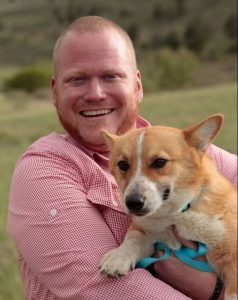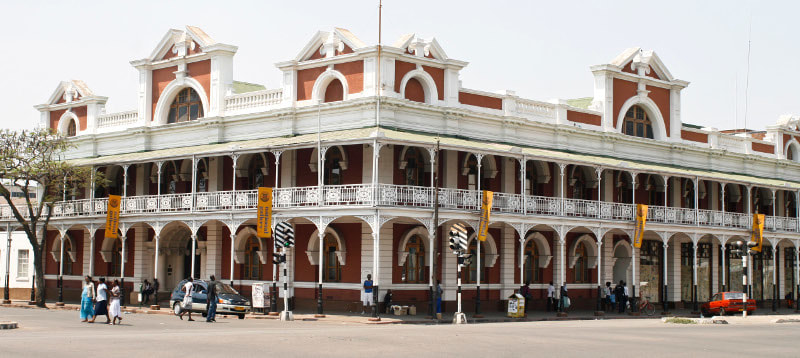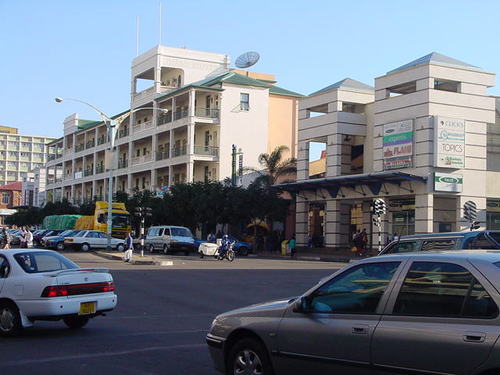As many of you know, Dr. James Arnett won a prestigious (and rare at UTC) Fulbright Core Teaching/Research Fellowship this past Spring. It’s a 10 month grant to teach at National University of Science and Technology in Bulawayo and conduct research on Bulawayo’s literary history, past infrastructure, and current programs for encouraging creative writing and literary production.
Check out Dr. Arnett’s first post, reposted here on our own blog, Connections. His post was originally published on his blog at http://jarnettphd.weebly.com/.

I arrived in Bulawayo at the tail end of their winter, such as it is. It’s more impressive a winter than you might think, given any image of Africa you might have as either a tropical or desertified climatological hellscape. The weather at night turns a crisp, cold and on its worst nights, the wind comes whipping up the plains – of Matabeleland, not Oklahoma. The buildings here are built for passive heating and cooling, although their proficiency at either is yet to be determined fully. Summer – a longer season, roughly nine months of the twelve – is on the horizon, and to hear it told – and felt – it began today.
I applied for the Fulbright to Bulawayo, Zimbabwe because it has a long history – it was the gateway of the Ndebele people fleeing Tchaka’s (of Zulu fame) despotic wrath. And it was the vista from the incomparable Matobos Hills that inspired British imperialist Cecil Rhodes to establish a private mining concern here, a concern that morphed into the colony of Southern Rhodesia (named after him, naturally). He asked to be buried here, and surprisingly, given the rancor and violence with which white Rhodesians defended their country against black African independence – it’s still up there, the grave, looking down on the first major city in Zimbabwe.
But Bulawayo also has a long history of artistic and literary sophistication, home to the Cyrene Mission (from which was derived an enduringly popular visual art), a regional hub for the author Doris Lessing during her youth in Rhodesia, home to the country’s National Gallery and Natural History Museum, and home or birthplace of Zimbabwean authors Yvonne Vera, NoViolet Bulawayo, John Eppel, and others.

Bulawayo is also a minority-majority city, home to the Ndebele people, a 20% minority in a country that overall identifies as roughly 80% Shona. The tribes have historically been pitted against each other, in spite of unifying in their long fight for independence against white Rhodesians that ultimately culminated in the independence of Zimbabwe in 1980. A young country, then, and the oldest town therein, Bulawayo has endured some pretty hard times, all told – especially considering it’s on the national government back-burner, which prefers to funnel money into the capital and other politically faithful towns. Throughout the 1980s, the majority government conducted a low-intensity and high-casualty campaign against the Ndebele, sowing ever greater distrust and fear amongst the Ndebele for the majority government. This erupted into politics at the turn of the 21st century, and Bulawayo became the center of an emergent opposition party, the Movement for Democratic Change. Since then, Bulawayo has positioned itself as a fiercely independent and resistant space in the country, questioning ZANU-PF’s thirty-seven year tenure as a majority government. Elections happen every five years, and the current president, Robert Mugabe, at the age of 94, is the oldest sitting statesperson in the world, and has publicly claimed that he has no interest in stepping aside, even as he wrestles with age and health issues. Thirty-seven years of power creates a tremendous amount of both momentum and inertia, and the vexing combination of both means that the upcoming elections in 2018 will, of necessity, be important to the shape of Zimbabwean politics to come.
It’s not terribly usual for literature professors to travel in search of literature – after all, books bring the world to us: such is their purpose and value, as records of ephemeral truths and vehicles of far-flung experience. But I’ve got a passion for travel, and a passion for travel in particular to the places where most other travellers don’t go. I taught for an ultimately ill-fated semester in Afghanistan in 2013, drawn there by my pacifism and my desire to see the workings of American Empire up close. It was probably an ill-considered decision, but I learned a lot – about American empire, about myself, about the value of the ideology of education and intellectualization. It has been impossible since to walk back those epiphanies – that education is incredibly impactful, the most potent force for the realization of freedom, equality, and justice.

The bus ride from Harare, fully six hours long (Africa is much larger than any map we’re familiar with represents it as), took me through a rusty, rocky, jutting landscape. An hour passed between remarkable towns, remarkable, mostly, for their ability to survive in this bone dry, elevated plateau. Kadoma. Kwekwe. Gweru.
Even in the cooler breeze of winter, I sweated in the double-decker bus, and strained my eyes, when it didn’t make me nauseous, for glimpses of anything worth remarking. I won’t lie, I was looking for exotic fauna, too, although they undoubtedly know better than to hang out anywhere near the one major highway cutting across the center of the nation. And contrary to the image one might have of Africa – as of wide open spaces, unbroken horizons, full of sky and burning land – it’s marked out and fenced just like America is, as glimpsed from the highway. More than a hundred years of colonialism, capitalism and private property have irreparably taken root, limiting, as we know, the ranges and spaces in which the charismatic African fauna can roam, confining them to the protected open spaces of national and game parks.

We pulled into Bulawayo, a gridded and bustling city, the regional hub for industry and commerce – or at least it was, until economic fortunes changed dramatically for the city, and the larger country, in the 21st century. Four faux-nuclear-cooling-towers (coal plants, it seems) tower over the edge of the city, whose skyline is broken by scattered, anomalous high-rises, all testifying to its importance, once, as a center of industry. Anywhere between 600k and 1 million people live here; the former is the government’s low-balled census number (determined, as it were, to downgrade the city’s importance), the latter the number that opposition politicians cite. Either way, there are certainly far more people on the street in Bulawayo at any time than there are in Chattanooga, proper.
The city’s architecture is a mix of buildings that wouldn’t look out of place on the mission coast of California, or the Victorian quarters of an English city, or the midcentury angular experimentation of once-thriving Rust Belt cities. It’s a random mix, but not without charm, even if it’s suffered pretty intensely from neglect and sometimes-explosive poverty.
But there are some buildings that are like time capsules, including and in particular the National Gallery of Art. A two-story building, painted red with white trim, its ornate balcony railings borrowed from the Victorian style of Cape Town, and which wouldn’t look out of place in New Orleans. It has a charming open-air courtyard, where a chic new coffee shop sprawls into the blue-bright glare of the cloudless sky. To one side is a two-story building, replete with a dozen studios for local artists to work and host buyers, students, and critics. It’s precisely the sort of place I love: full of art, full of history (it was built at the turn of the 20th century), but most of all, full of the memory of literature.
For many years, Yvonne Vera, the lyrical, ambitious, and avant-garde Zimbabwean writer, was the curator here. Her tenure in charge is remembered fondly by all as a high point in the institution’s history, and she was a tireless advocate for artistic production and preservation, a steward to the unique cultural traditions of the town, and a local human repository of memory for the city. When the eminent historian of Rhodesia/Zimbabwe, Terence Ranger, decided finally to approach Bulawayo as a subject, he tipped his hat to, and started with, Vera’s fictional account in her novel, Butterfly Burning.
Vera’s novels range over the full modern history of Zimbabwe, variously touching on all of the important eras, from the first Chimurenga (roughly glossed as <righteous conflict> or <revolutionary struggle>; 1894-1897) against white imperialists, through the resource plunder of Zimbabwe while a colony, into the difficulties of the Second Chimurenga (1966-1979) against the Rhodesians, and into the turn of the 21st century. Her novels are wrenching, and disorienting, and stand out in a field of literature that has been, and still largely is, dominated by social realist novels in the Chinua Achebe tradition.
Vera’s novels are wrenching and disorienting, replete with ruefully casual violence, and dwelling uncomfortably on trauma. In December of 2016, I travelled to the Harry Ransom Center Archive at the University of Texas-Austin, a famous collection of very important literary manuscripts, with heavy concentrations on 20th-centry British and African literature. They have a larger and more complete collection of Doris Lessing’s correspondence and manuscripts than found anywhere else. And buried amongst the papers of the African literature scholar Charles Larson is a small cache of papers of Yvonne Vera’s –letters and emails, copies of essays and articles, handwritten notes, and Terence Ranger’s eulogy for her. Most remarkably, though, when Vera died in 2005, she left behind a nearly-complete manuscript, now archived amongst Larson’s papers at UT, named Obedience. This novel begins with the uncovering – and plunder – of the stone birds at Great Zimbabwe, a kind of ground zero for colonialist appropriation of ersatz-“primitive” cultures that characterized the “cultural labor” of colonialism.
Archives can – in their best moments – yield precisely such gems: unfinished work, notes for projects that were never realized, casual insights into literature’s composition. Although Larson wanted very much to publish the novel – and corresponded with her husband about her planned revisions – and Sarah Kastner worked with the manuscript for her MA thesis, “Writing Against Possession: Archiving Yvonne Vera, and the Obedience Manuscript,” the text is still not available outside of archives. It remains, therefore, a tantalizing promise of what could have been, as well as a novel in situ, waiting for its hopefully-eventual publication.
Although Vera passed in 2005, her mother still lives in Bulawayo, and it seems that she has taken up the banner of her late daughter. She has compiled a biography of Vera – the only one, I believe – and also become a writer in her own right. I hope to meet her, to let her know how important and impactful Vera’s work has been, is, will be – that she has been and will be celebrated as one of the most important and idiosyncratic voices in all of African literature. I don’t doubt her mother knows this, of course, in the way that mothers do.
I’ve always loved literature, and by extension, those writers who have poured their blood and sweat into these texts that give me life, but I’ve always been sceptical of the Romantic notion of the isolated, tortured, god-appointed ‘genius.’ It’s a holdover from less egalitarian times, this idea that some people are uniquely imbued with otherworldly powers of expression that render them godlike among men. My investment in materialist philosophy inclines me to want to believe that people are made, shaped, formed; they push and are pushed; they stretch and snap back; and around all of us swirls a dense cloud of ideologies about the world that allow us to understand ourselves as ourselves, and the world as the world – and that that fact means that we all inhabit different registers of experience in and of the world. Short-hand: poststructuralist materialist Marxist.
Nevertheless, for the same essential reason that people make pilgrimages to the Land of Mickey in order to asymptotically approach the impossible Disney fantasy through hyperconsumerism… I want to be where the writing was. I want to see – want to see them writing, see them writing on – what do you call those? Desks?
I’ve seen Marcel Proust’s recreated bedroom in Paris; the tree under which Lawrence Durrell wrote his Mediterranean travelogues in Northern Cyprus; the towering pine tree that DH Lawrence stared out of the window at in Taos, NM; Hawthorne’s House of Seven Gables; Stein’s and Hemingway’s and Fitzgerald’s and Joyce’s Shakespeare and Company; Larry McMurtry’s Archer City, Texas; Amma Darko’s Agbogbloshie Market in Accra.
When I’m feeling uncharitable to myself, I think: what are you doing? What do you imagine you’ll find? The writing is over; the book is in your hands; the text is what lives, such as anything can be said to ‘live.’ Give up the search, enjoy the book, accept that that time, that place, that moment, that person is gone, and it is precisely the text that remains when nothing else does.
On the other hand, I think – here is a city, Bulawayo, somewhat frozen in time, haunted by its past and uncertain about its future; unupdated since 1980; slowly decaying under the whiplash of the wind, the abrasion of the ruddy dust, the weight of history. Toni Morrison was right, you know, when she described “rememory” in Beloved – places that have seen life, and history, and violence and death and trauma and pain and love and joy and fear, record these feelings in their bones. And their bones are the width of the streets of Bulawayo, designed to allow a full complement of oxen to effect a U-turn in the middle of the street, and streets which are still used for this effect by hand-me-down double-decker buses shuttling people between the blasted capital and the buffeting winds of Bulawayo. And the bones are those ornate white railings of the National Gallery, chipping paint now that Yvonne is gone. And the bones are the corner public library, whose stock of schlock fiction and time-warped classics impresses. And the bones are in the stout and flaring coalstacks on the edge of the ridge that once intentionally separated the ‘native’ town, Mzilikazi, and the rest of bleached, whitened Bulawayo arraying themselves in the orderly grid, out of plumb with north and south, but arranged on lay-lines of topography and romantic imperial visions. And the bones are in the irrepressible warmth of a people who should, by logic and experience and history, be sceptical of my wondering and wandering eyes, but haven’t. All of these places contain layers of life and lived experience, the residue of our bodies and the signatures of our sacrifices.
Leave a Reply